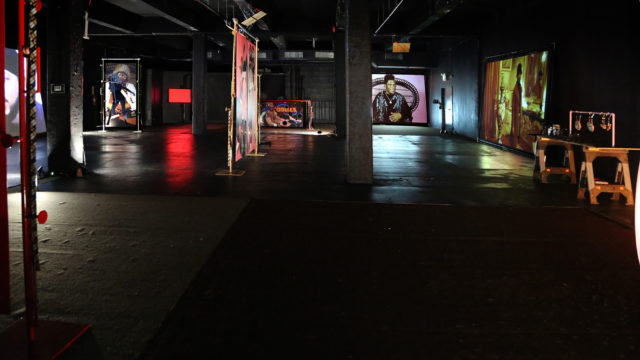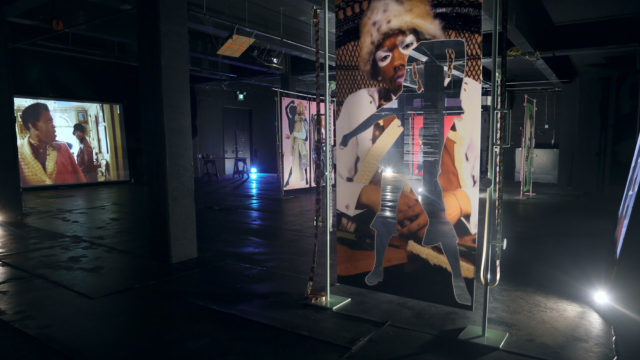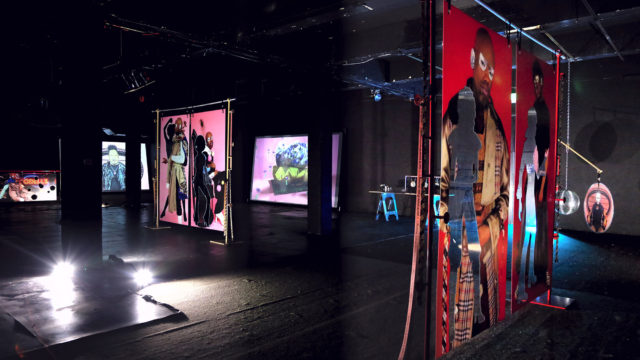Wickerham & Lomax: DUOX4Odell’s: You’ll Know if You Belong
The Former Everyman Theater
1723 N. Charles St, Baltimore MD
March 31 – April 28
Closing reception 7:00 p.m. – 10:00 p.m.
Presented by Light City and the Station North Arts & Entertainment District
I have a soft spot for any exhibition that’s promoted with coasters left in gay dive bars.
In this case, coasters featuring local personalities Elon Battle and Keenon Brice, painted silver, posing in fashion-editorial-like tableaus advertise: DUOX4Odell’s: You’ll Know If You Belong. They lead visitors to an abandoned theater, where collaborators Wickerham & Lomax have staged an installation inspired by an even more abandoned nightclub. The space is dominated by industrial-looking contraptions that hang larger-than-life prints from the coaster photoshoot, loosely framed by three even larger projection screens. They’re printed on plexiglass, overlapping with transparent silhouettes evocative of 70s Blaxploitation posters. Theatrical lighting streaks across the floor, like disco lights fallen from the ceiling, occasionally casting faint projections of the dancing figures on the black walls, giving the impression of an archaic iPod commercial. Only visible up close, tiny blocks of poetry are printed into the negative space.
I’ve visited Wickerham & Lomax’s ambitious installation more times than I can count. But it didn’t occur to me why the space feels so uncomfortable until I attended a discussion between the artists and the philosopher Luce Delire, who bluntly stated that her first reaction to the work was disappointment: “When I first came in I was expecting something celebratory.” Instead, an almost sullen, eerie vibe hangs over the work.
The installation feels a bit like a funeral for a queer time traveller, glamorous but sad. It’s not what one would picture as existing in the realm of “community arts”—the project was commissioned through Neighborhood Lights, the community-focused satellite programming of the Light City festival. And Wickerham & Lomax are even less likely to be described as “community artists”. Their rabbit hole of multimedia work—full of allusions to past projects, inside jokes, and everything from pop references to critical theory—isn’t always “accessible”, even to many in the arts. But the one constant with Wickerham & Lomax’s work is surprise. I’ve known the two for years (full disclosure: they rent their studio space from me, and we’re good friends) but despite this familiarity, their work is seldom what I expect. How does one evaluate a show that seems, on some level, to be about the futility of its own nostalgia?
I’m not sure I can. Most of the work is polished and beautiful. Parts of a documentary-style video feel important as a piece of untold oral history. But as a whole, I can’t place exactly why I like the exhibition or why it simultaneously leaves me feeling unfulfilled. I suspect that feeling of unfulfillment is deliberate. They’re not trying to give us a simulacrum of fun. In one video, “Wormholes Robert + Allen”, a couple sits at home, surrounded by moving boxes. They’re debating going out dancing, and talk about the impending death of one man’s estranged father. It’s hard to watch, and feels almost like a home movie not intended to be seen by others. It’s not readily apparent how the piece relates to the rest of a show about an abandoned disco. It ends with them dancing alone at home. It’s aesthetically incongruous, but speaks to notions of loss and placelessness.
DUOX4Odell’s: You’ll Know if You Belong, which closes tonight in Baltimore’s former Everyman Theater, is the result of a months-long research project. The pair were partnered with the rapidly-gentrifying neighborhood Station North, which until about a decade ago was known as Charles North and was a center of the city’s LGBTQ Black community. At the heart of the neighborhood, a block away from the theater, stands O’Dell’s, a disco that operated from 1976 to 1992. Since closing, it’s sat vacant and fallen into disrepair (it was recently purchased by a developer with plans for coworking space). DUOX4Odell’s is less about resurrecting the club for one last wild night, and more about admitting that task is impossible—through interviews with former patrons that inform meandering collaborations with their peers.
For anyone who came of age gay and/or weird in Baltimore in the past few decades, O’Dell’s holds a special allure. It’s a place of not-so-distant mythology. A discotheque with a curious facade, it’s felt like a mysterious ruin from a bygone civilization since the 1990s. My eccentric former landlord used to regale us with unsolicited stories of drug-fuelled nights there with drag icon Divine. The old drunks at gay dive bars tell kids-these-days about the better fashion of yesteryear. Countless art students have broken into its abandoned dancefloor for midnight photoshoots. But for those who wistfully remember the club’s heyday in the late 70s and early 80s, there’s a sharp thorn of sadness in the side of all that glamour.
Wormholes Odell’s from duox on Vimeo.
The more documentary-style “Wormhole O’Dells” begins with the building’s current owner leading the camera through the gloomy, dilapidated former dancefloor, excitedly talking about the flexibility afforded by column-free floors. It transitions to interviews with former regulars, such as Chuckie Dennis, who explains “Going to O’dells in those days gave us a sense of identity… O’dells brought glamour to Baltimore.” The oral histories, many of which focus on the rituals of dressing up for nightlife, are intercut with snippets of disco and poetry by Janea Kelly and Malcolm Lomax. It seems every humorous anecdote is balanced by a sentiment of loss or regret.
“The doors trembled, quaked not knowing that music had a grudge against exclusion.
That music would pass through the membrane, inciting and inspiring.
That music would be a contagion if caught, turns bodies into brick and mortar – turns gentrification into a common cold.
Lump of flesh not just corpse and cadaver but sentient forms that knew love and its expression.
Let me fall somewhere between two pillars and let them catch me, and I’ll be burning wounds to prevent infection.
They, in not knowing me, ripped my innards out – a horror, gore, zombie fuck. A string of one-night stands going from one owner to the next. Causing whole communities to look like shells or fallen soldiers in war-torn Baltimore, fixated only on keeping composure.
Can there be a process, a practice, a poetics to knowing [remove the word “that” here] the pulse of city as body and buildings as organ? Would our steps to render them living make us better care for them”-From ODELL’S FLESHY EDIFICE (SPACE)
It’s hard at first to see the connection with the other two videos. In “Wormholes Antiques,” frequent Wickerham & Lomax collaborators Blairè Leòn and Kentrell Searles search a cluttered antique store for a gift for Blairè’s love interest, an older man. The two exchange quips with each other and the store’s proprietor, who warns them that used objects carry with them the memories of previous owners. It feels a bit like a caveat for the gentrifiers circling Baltimore’s historic building stock—perhaps all the “character” and curb appeal that old buildings possess might include the ghosts of former occupants. The video ends with Blairè walking away holding a vase stuffed with peacock feathers, a motif that recurs throughout the videos and photo installations.
But one question from the video, directed at the camera by the antique store owner, sticks with me the most: “So you guys come around, prying into other people’s lives… why are you so curious about back histories? Are you storytellers? Old World gossips? New World liars?”
This perhaps gets to the root of the exhibition’s (seemingly deliberate) awkwardness. Wickerham & Lomax made it clear they don’t want to recreate the experience of the club, or delve too deeply into nostalgia. And they certainly don’t want to tell someone else’s story. The installation feels instead like a reflection on the O’Dell’s-shaped-hole in their own lives, or the idea of loss at its most obtuse. It touches on the disruptive nature of gentrification in queer and Black communities, but explores the feeling through extended metaphors more often than direct political finger wagging. Kimi Hanauer, Program Director for Station North introduced the work as “a positive interruption to some of the changes that are happening in the city.”
Daniel Wickerham, in their discussion with Luce Delire, described the frustrations of working with someone else’s histories: “How inefficient is it to ask someone to give you their memories? Its failure of being so boring. I wanted to ask ‘remember better! Remember differently… just make it up!’ I want to be dazzled.” But also the problems of using those memories for entertainment: “It’s about negotiating responsibility… are we allowed to access the space we’re working through?”
You’ll Know if You Belong references O’Dell’s signature catchphrase, and it’s evident that here no one belongs anymore. Malcolm Lomax explained that the installation was conceived shortly after the Pulse nightclub shooting in Orlando, in the midst of a years-long trend of gay bars shuttering. The story of O’Dell’s regulars, for all its specificity, became a starting point to describe queer placelessness and loss in more abstract terms. Referencing the numerous allusions to absent bodies (the silhouettes, shots of empty spaces) he summarized the project as “Eulogizing. It’s about the way we frame absence… at one point in a poem I ask ‘am I a church housing my own funeral?’ It’s about these empty spaces in Baltimore where we’re still negotiating their uses.”
The more I return to the space, attempting to center my thoughts about the show, I find myself gravitating to Lomax’s poetry. Interspersed throughout the video works or printed on the sculptural image/objects, it remains one of the most salient components of the show:
“The way tears cause avalanches
Is the way orgasms cause earthquakes,
But my body is still a stranger to this Earth.
And because this planet is dying, an ad is placed:
Kinky club seeks asylum on another planet.”–From Monuments & Moments:
AM I OLD? (TIME)






Comments on this entry are closed.